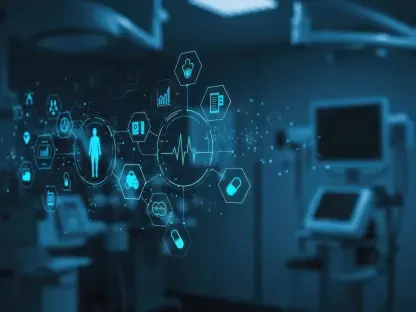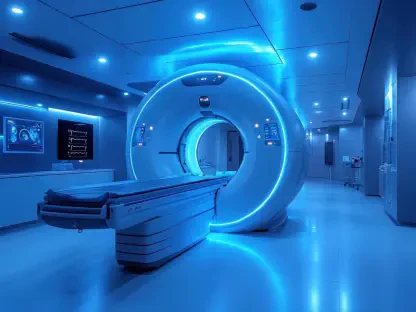Amid the growing digital evolution in healthcare, ransomware attacks present escalating challenges that threaten sensitive patient data and the continuity of essential operations. Recent trends showcase a significant shift in how healthcare entities address these cyber threats. This analysis explores the decreasing trend in ransom payments by healthcare organizations, driven by enhanced cybersecurity investments, regulatory oversight, and evolving threat actor strategies. As healthcare providers face increasing pressure to ensure data security and operational continuity, understanding these trends is crucial for navigating the ever-changing cybersecurity landscape.
Current State of Ransomware in Healthcare
Fluctuations in Ransom Payments and Cybersecurity Investment
Healthcare organizations are strategically reducing ransomware payments, indicating a notable shift in response protocols. In 2024, a conspicuous 35% decline in total ransomware payments was observed, with amounts dropping to $813 million from $1.25 billion in the prior year. This descent underscores that ransom payments are becoming a more exceptional circumstance. Heightened investments in cybersecurity have played a pivotal role in reshaping this landscape. From 2025 onward, IT budget allocations have risen to 14%, showcasing an unwavering commitment to fortifying defenses against burgeoning threats. Reports from credible sources such as HIMSS confirm these patterns, with fewer institutions succumbing to ransomware demands as bolstered security measures take precedence.
Implementing Advanced Security Protocols
Healthcare organizations are embracing innovative cybersecurity technologies to safeguard their infrastructure more effectively. Leveraging modern backup solutions, such as immutable storage and air-gapped backups, has empowered providers to independently restore operations without relying on attackers. Furthermore, the deployment of defensive tools like Endpoint Detection and Response (EDR) and Managed Detection and Response (MDR) enhances system resilience, creating formidable barriers against ransomware penetration. As case studies highlight, healthcare entities adopting these protocols experience diminished instances of successful attacks, signifying a promising shift toward bolstered cybersecurity.
Expert Insights on Evolution of Ransomware Strategies
Redefining Cybersecurity Tactics
Industry experts are observing shifts in ransomware strategies towards data exfiltration and extortion. This evolution represents a pivot from encryption-based attacks, with criminals now threatening to expose sensitive data unless demands are met. Protected Health Information (PHI) becomes an attractive target, pressuring organizations to navigate complex data privacy laws while dealing with threat actors. Thought leaders assert that this shift demands comprehensive strategies that focus on fortifying data protection measures, emphasizing collaboration with entities like the Health Information Sharing and Analysis Center (H-ISAC) to ensure effective threat anticipation.
Regulatory Pressure and Cyber Insurance Impact
The impact of cyber insurance and regulatory frameworks adds a significant dimension to the ongoing transformations in ransomware landscapes. As insurers refine risk assessments, stricter security protocols are required before coverage is offered, minimizing ransom payments and incentivizing robust cybersecurity practices. Concurrently, regulatory entities such as OFAC are deterring ransom payments by imposing strict penalties for transactions with sanctioned groups. Experts emphasize that these factors contribute to reducing ransomware’s financial appeal while intensifying awareness among healthcare providers about policy compliance risks.
Future Prospects for Cybersecurity in Healthcare
Projecting Ransomware Trends and Implications
Future prospects in cybersecurity suggest an optimistic trajectory for healthcare organizations combating ransomware threats. Continued investment in cutting-edge technologies, adherence to regulatory standards, and collaborative efforts are anticipated to bolster defenses significantly. The healthcare sector is poised to enhance its resilience through integrated security frameworks designed to address evolving attack methodologies. With proactive measures focusing on data protection, organizations can mitigate ransomware risk while fostering a more secure environment for patient care and operational continuity.
Transitioning Toward Collaborative Defense Technologies
In the evolving cybersecurity ecosystem, strategic partnerships and shared intelligence stand as definitive pillars for future success. Collaborative initiatives between law enforcement agencies and healthcare providers ensure timely threat response, reducing the overall impact of ransomware incidents. As the industry embraces these advancements, the establishment of collective defense mechanisms is likely to redefine how organizations approach cybersecurity challenges, facilitating adaptive responses that counter emerging threats effectively.
Addressing the Evolving Ransomware Landscape
The changing landscape of ransomware in healthcare reflects both progress and challenges, with organizations increasingly prioritizing cybersecurity enhancements. By adopting proactive strategies and embracing collaborative initiatives, healthcare providers can navigate threats more adeptly, securing patient data and operational integrity. Given the evolving ransomware tactics, healthcare stakeholders are encouraged to explore comprehensive security measures and foster industry-wide collaboration, ultimately contributing to a resilient future against cyber threats.









